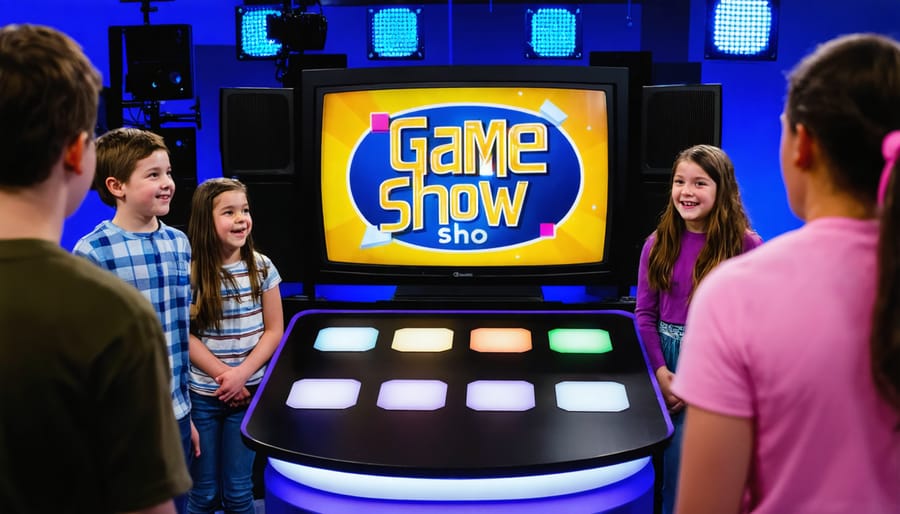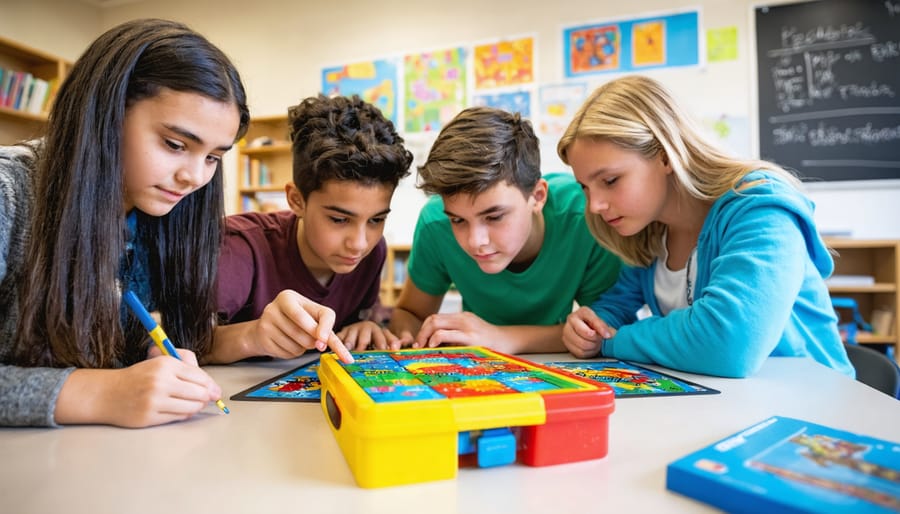Team Building Activities That Actually Get 7th Graders Working Together
Seventh graders live in that tricky middle ground—too old for childish games, too young for adult-style team builders. They’re navigating complex social dynamics, testing boundaries, and desperately trying to look cool in front of their peers. That’s exactly why traditional team building activities often crash and burn with this age group.
The secret? Disguise collaboration as competition and fun. When seventh graders are engaged in a fast-paced game show format or solving a mystery together, they naturally work as teams without the awkward forced bonding that makes them cringe. They need activities that respect their growing independence while channeling their energy into positive group dynamics.
Transform your classroom into a space where teamwork happens organically through game-based challenges that tap into their competitive spirit and love of winning. Puzzle-solving activities work brilliantly because they require genuine collaboration—no single student can dominate, and everyone’s input matters. Quick five-minute energizers keep the momentum going without losing their notoriously short attention spans.
The activities ahead are specifically designed for seventh grade social dynamics. They’re customizable to your classroom needs, require minimal prep time, and actually work with this challenging age group. Whether you need a full-period team builder or a quick brain break, these strategies will help your students develop collaboration skills while having genuine fun—no eye-rolling required.
Why 7th Graders Need Team Building (And Why Traditional Methods Often Fail)
Let’s be honest – seventh grade is a unique beast. Your students are navigating a social landscape where sitting next to the “wrong” person feels catastrophic, and anything that smells like a “trust fall” will earn you instant eye rolls. This age group is caught between childhood and adolescence, making traditional team building feel forced and frankly, cringe-worthy.
The challenge? Established cliques make collaboration difficult, social awkwardness runs high, and students are hyper-aware of how they’re perceived by peers. They’ll resist activities that feel like you’re trying too hard to make them “bond.” And here’s the thing – they can spot inauthenticity a mile away.
That’s exactly why game-based approaches work beautifully with seventh graders. Games naturally create a level playing field where the focus shifts from social hierarchies to achieving a shared goal. When students are racing against the clock in a quiz show format or solving a puzzle together, they’re too engaged in the challenge to worry about who’s “cool” or whether the activity is “babyish.”
The magic happens because games don’t announce themselves as team building. There’s no awkward “now we’re going to learn to work together” speech. Instead, collaboration emerges organically as students realize they need each other’s strengths to win. The quiet student who’s great at logic puzzles suddenly becomes valuable. The class clown’s creativity saves the day during a brainstorming round.
Game-based activities also allow for customization, so you can adjust difficulty levels and themes to match your students’ interests and maturity. This flexibility means you’re meeting them where they are – not where a generic team building manual thinks they should be.

Game Show Style Activities That Break Down Social Barriers
Trivia Tournaments with Built-In Collaboration
Trivia games become powerful team builders when you structure them to require genuine collaboration. The secret? Make discussion mandatory before teams can submit their answers!
Set up your trivia tournament with clear collaboration rules. Give teams 30-60 seconds per question to discuss their response before one designated “answer captain” (rotate this role!) shares the team’s final answer. This prevents one student from dominating and ensures everyone participates in the decision-making process.
Try using Family Feud-style games where teams must rank multiple possible answers together, or Jeopardy-style templates where they choose categories as a group. Both formats naturally encourage debate and consensus-building.
Want to boost collaboration even more? Award bonus points for teams that can explain *why* they chose their answer, not just what they answered. This shifts focus from simply knowing facts to communicating reasoning—a critical skill for 7th graders to develop.
Keep teams small (3-4 students maximum) so everyone has a voice, and mix up team compositions between rounds. You’ll notice students practicing active listening, respectful disagreement, and compromise—all while having fun competing!
Relay-Style Review Games
Relay-style review games bring an energizing twist to test prep while building teamwork skills your 7th graders desperately need! These activities get students moving, thinking, and supporting each other toward a shared goal.
Try a classic relay race format where team members run to the board one at a time to answer different questions. Each student contributes their strongest subject area, teaching them that everyone’s unique skills matter. You can customize this by assigning roles—one student might be the “fact checker,” another the “speed writer,” and someone else the “strategist.”
**Progressive story relays** work wonderfully too! Teams sit in lines, and each person adds one sentence to a story based on your curriculum topic. The creativity and laughter that emerge help break down social barriers while reinforcing content knowledge.
For a quieter variation, create **puzzle relays** where each team member holds different clues or puzzle pieces. They must communicate effectively to assemble the complete answer—maybe a historical timeline or a science process diagram.
The beauty of relay games is their flexibility. Adjust the pace, content difficulty, and physical requirements to match your classroom space and students’ needs. Some teams will naturally develop leadership roles while others discover hidden strengths, making these activities perfect for building confidence in middle schoolers who are still figuring out where they fit.
Problem-Solving Challenges That Require Every Team Member

Escape Room Style Classroom Activities
Escape rooms have become wildly popular, and the good news? You can bring that same excitement right into your classroom! With PowerPoint and customizable templates, you can create puzzle-based activities that perfectly match whatever you’re teaching—from math equations to historical events.
Here’s what makes these activities perfect for 7th graders: they naturally require teamwork without feeling like a forced “team building exercise.” Students must communicate, share ideas, and solve problems together to “escape” within the time limit. The competitive element keeps them engaged while the collaborative nature builds those essential social skills.
Start simple with a three-puzzle room that takes 15-20 minutes. Each puzzle unlocks a clue or code needed for the next challenge. You can theme everything around your current unit—imagine a science escape room where students solve problems about the periodic table, or a literature challenge based on your novel study.
The beauty of digital escape rooms is the customization. Adjust difficulty levels, add hints for struggling teams, or create multiple versions so groups can compete simultaneously. Plus, setup is minimal—just project it on your board and let the adventure begin!
Mystery and Detective Games
Seventh graders absolutely love the challenge of cracking codes and uncovering secrets! Mystery and detective games tap into their natural curiosity while building critical thinking skills in a seriously fun way.
Try creating a classroom “whodunit” where teams work together to solve a fictional crime. Set up different stations around your room with clues—fingerprints, witness statements, coded messages—and watch as students collaborate to piece together the puzzle. You can easily customize the mystery’s difficulty level and theme to match what you’re teaching, whether it’s historical figures, literary characters, or science concepts.
Escape room challenges are another fantastic option that gets everyone involved. Design a series of locked boxes or puzzles that teams must solve within a time limit. The beauty here is that every student brings different strengths—some excel at logic puzzles, others at pattern recognition, and some at creative thinking. They quickly learn that pooling their talents is the key to success.
For a quicker activity, try “Two Truths and a Lie” with a detective twist. Students work in teams to investigate claims by asking strategic questions and gathering evidence. This builds both deductive reasoning and communication skills while keeping everyone engaged and laughing together.
These activities naturally encourage cooperation because no single student can solve everything alone—teamwork becomes essential, not forced.
Quick Team Builders for Any Time You Need Them
Fast-Paced Board Game Adaptations
Board games aren’t just for game night anymore! Quick adaptations of popular games create fantastic team building opportunities that fit perfectly into your class schedule. The best part? You can customize these activities to match whatever you’re teaching.
Try speed versions of classics like **Pictionary** or **Taboo** with academic vocabulary. Split your class into teams of 3-4 students and give them 10-minute rounds. Students love the competitive energy, and you’ll see even reluctant participants jump in when the timer starts ticking.
**Codenames** works brilliantly for building communication skills. Create custom word cards related to your current unit, and watch teams develop strategies together. It’s amazing how quickly seventh graders learn to read each other’s thinking patterns!
For something more active, adapt **Jenga** into a review game where each block pulled requires answering a question. Teams work together to decide which blocks are safest and collaborate on answers.
These games typically run 15-20 minutes, making them perfect for those transitional moments in your day. Plus, you can create themed versions for any subject area. Keep several options ready to go, and you’ll have instant engagement whenever you need it!
Brain Teaser Challenges
Get your students’ competitive spirits flowing with brain teaser challenges that transform problem-solving into an exciting team sport! These quick-fire activities are perfect for 7th graders who love a good mental challenge.
Set up stations with different types of puzzles—riddles, logic problems, visual brain teasers, and word puzzles. Divide your class into small teams of 3-4 students and give them 5-10 minutes per challenge. The key is variety! Mix up difficulty levels so every team experiences both struggle and success.
Try classic puzzles like “Three people check into a hotel” riddles, lateral thinking problems, or pattern recognition challenges. You can also customize puzzles to match your current curriculum—math word problems presented as mysteries or science-based logic puzzles work wonderfully.
What makes these activities shine is watching students naturally divide responsibilities. Some become the out-loud thinkers, others sketch diagrams, and some focus on connecting clues. This organic role distribution builds communication skills without any forced structure.
Keep the energy high by announcing when teams solve puzzles and maintaining an upbeat atmosphere. Remember, the goal isn’t just finding answers—it’s learning to think collaboratively under friendly pressure!
How to Form Teams That Actually Work
Let’s be honest—seventh graders can sniff out forced groupings from a mile away. The key to forming teams that actually work isn’t just about mixing things up randomly; it’s about being intentional while keeping it fresh.
**Mix It Up Strategically**
Instead of letting students pick their own teams (hello, cliques!) or always going alphabetically, try different grouping methods throughout the year. Use playing cards to create groups by suit, count off in unexpected patterns, or group by birth months. The variety keeps students from feeling like they’re always stuck with—or separated from—the same people.
**Balance the Strengths**
Create teams that blend different skill sets and personalities. Pair your natural leaders with quieter students, mix athletic kids with creative thinkers, and avoid stacking all your high-achievers on one team. You’re not tracking abilities—you’re building complementary teams where everyone has something valuable to contribute.
**The Two-Friend Rule**
Here’s a game-changer: allow each student to work with one friend, but not their entire crew. This gives them a comfort zone without recreating the same social dynamics that cause problems. Students feel less anxious while still being pushed to connect with new classmates.
**Rotate Team Roles**
Within each team, assign rotating roles like timekeeper, encourager, recorder, or materials manager. When everyone has a specific job, there’s less room for one person to dominate or others to tune out. Plus, students develop different skills and see their classmates in new ways.
**Keep Teams Small**
Four to five students per team is the sweet spot. Smaller groups mean everyone participates, and there’s nowhere to hide—but they’re still large enough for diverse perspectives and collaboration.

Making Team Building Work All Year Long
The secret to successful team building isn’t found in one amazing activity—it’s about weaving collaborative experiences into your everyday classroom routine. When you make teamwork a regular part of your 7th graders’ school experience, those initially awkward group moments transform into natural opportunities for connection and learning.
Start small by incorporating quick team activities at the beginning or end of class a few times each week. Even five-minute games can shift the energy in your room and remind students that collaboration is fun. The key is consistency—students start expecting and looking forward to these moments together.
Here’s where the magic really happens: customize your team building games to match whatever you’re teaching. Studying the solar system? Turn a trivia game into a space exploration challenge. Working on vocabulary? Create a word puzzle race. When team activities connect to your curriculum, they stop feeling like “extra” time and become powerful learning tools that your students genuinely enjoy.
Don’t underestimate the power of scoreboards and sound effects to amp up engagement! Middle schoolers love a little friendly competition, and these elements add excitement without much effort on your part. Display team scores on your projector, play celebratory sounds for correct answers, or use timers to create urgency. These simple additions make activities feel more official and engaging.
Mix up your team compositions regularly too. Sometimes use random groupings, other times let students choose partners, and occasionally assign strategic pairings. This variety keeps things fresh and helps students develop flexibility in working with different personalities.
Remember, you’re building a classroom culture where teamwork feels natural, not forced. Keep it fun, stay consistent, and watch your 7th graders transform into collaborative superstars!
Building a collaborative, enthusiastic classroom starts with just one activity. You don’t need to overhaul your entire teaching approach overnight—the beauty of team building activities for 7th graders is that even a single five-minute game can shift the energy and strengthen connections among your students.
Start small and watch what resonates. Choose one activity that feels manageable for your classroom setup and schedule. Maybe it’s a quick would-you-rather question during morning announcements or a Friday Feud competition to review the week’s lessons. Pay attention to what gets your students excited and talking, then build from there.
Remember, consistency matters more than perfection. Regular team building experiences, even brief ones, create a foundation of trust and communication that transforms how students work together. These moments of fun and connection aren’t extras—they’re essential ingredients for a learning environment where middle schoolers feel safe to take risks, share ideas, and support each other’s growth.
Your students will thank you for making learning more enjoyable, and you’ll appreciate the collaborative classroom culture that develops naturally through play and shared experiences.


